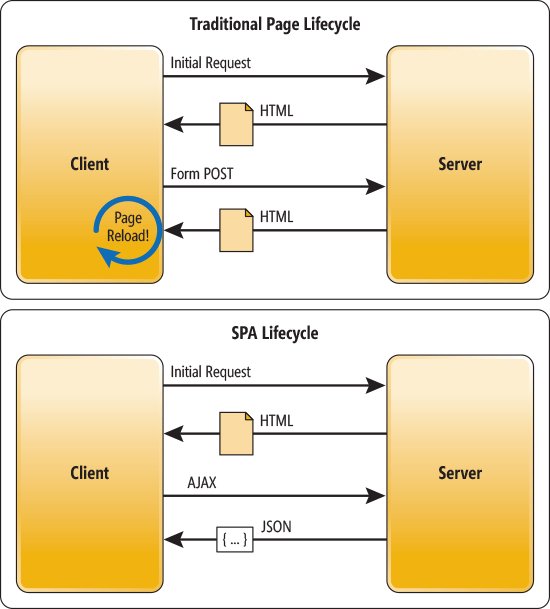The competition in online marketing is increasing. People finding the easiest and short ways to win the marketing race. This is the reason single-page websites gained popularity day by day.
Many companies advertise a single product or a specific niche on their one-page website. But, in terms of SEO, are single-page websites good or bad?
In this article, our SEO experts explaining about the pros and cons of single-page websites in terms of SEO. Let’s start it.
What Is A Single-Page Website?
A single-page website differs from a one-page website in some ways. A one-page website has no navigational links that take you from point A to B, as there would normally be in many other types of web design templates.
A single-page website is an application that dynamically displays content from the server in response to user interaction on each page.
Users click on navigation links to jump (or scroll) to destinations further down the page. This interaction gives the impression that the page is changing; however, there is no page refresh.
The below illustration gives the difference between how a standard page interacts with the server and how a single page interacts with the server.

SEO Pros And Cons
Most of the best SEO companies in India have differing opinions on whether single-page websites are a good choice when it comes to search engine optimization. It looks like there are two thoughts of a single story on this subject. Here I’ll explain the SEO pros and cons of single-page websites.
Pros
Let’s start with some of the advantages, or perks, of using single-page web design.
PageRank
Links are one of the largest factors that determine how well a website ranks. The benefit that single-page websites or landing pages have to go for them is that when people do end up visiting the page they are far more likely to link to it because there will be no other choice.
Each page on a site like this is its own unique URL. So obtaining any number of links from other websites or social media activity ratings always end up with a 1:1 ratio.
Better Mobile Experience
According to Google, 57% of internet users exclusively access the web using mobile devices.
In 2019, Google announced they are working towards shifting their search strategies to favor mobile-first indexing. The simple reason for this is that most people are now using their phones to find what they need where ever they may be.
While there are many advantages to building mobile sites and apps, one of the major advantages is that the sites convert much easier so it means your website has a better chance of being found by Google through either a smartphone or tablet.
A single-page website has an advantage in terms of mobile-first indexing and also loads much faster than multi-page websites.
Target A Specific Audience
In terms of SEO, single-page websites are great for targeting a specific audience. You can track the user behavior easily as they have no chance to click on another page.
By using single-page sites, you can present all of your information to users on one page, in whatever order you choose to suit the needs of your business or life.
In SEO terms, this can be important if there is only one keyword or set of keywords you’re worried about targeting.

Cons
A single-page website has many benefits in terms of SEO but all of your business information showing on one page is bound to have some drawbacks.
Here are some of the ways that a single-page website might hurt your SEO.
Limited Keyword Targeting
Keywords are the crucial aspects of search engine optimization. In single-page websites, you are bound to target a limited range of keywords which also limits the target audience. It means you cannot target a wide variety of keywords.
If your goal is to find new customers, then the single-page website is not a good option for you. To reach a larger audience, you should construct a multi-page site with various keywords on each page.
But if your business model isn’t centered on search engine optimization, you shouldn’t be as worried about keyword rankings.
Content Lacks Detail
Another downfall to single-page sites is that you don’t have the option of placing your content on separate pages when you own a single-page design.
We know how difficult it can be to organize a lot of information within one page, but even if you have so much to say about your topic.
It’s hard to fit the same amount of information onto a single page as it is on numerous pages.
Minimal Advanced SEO Strategies
On single-page websites, you cannot implement advanced SEO strategies. To know more about it, let’s clear this point with a silo structure.
A content silo is a search engine optimization (SEO) technique that entails organizing your website’s content around keyword-based topics.
In simple terms, creating a silo structure on your website essentially means organizing related and relevant material into discrete areas.
This is the best SEO practice to rank the variety of keywords for your website. And it would be useful for multi-pages websites not on a single-page website.
Conclusion
In my opinion, single-page websites are not good for SEO as it creates limitation for keywords and content placement. But that doesn’t mean the single-page design is worthless.
It totally depends on our primary goal and what we need to accomplish. Single-page websites are useful for PPC advertising where you can show all the information in a small piece of content. With paid ads, users can easily reach your one-page website and it could be a huge chance to land users on your multi page-site.
BMN Infotech is the best web design company in Amritsar, India. So, if you want to create a single-page website and a multi-page website for your business, contact us today!

